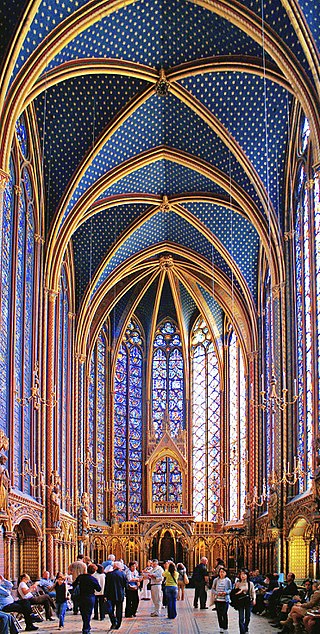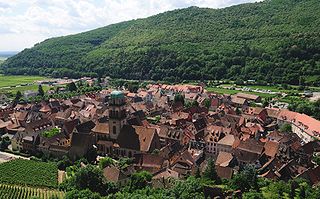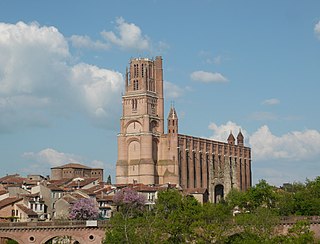
The Sainte-Chapelle is a royal chapel in the Gothic style, within the medieval Palais de la Cité, the residence of the Kings of France until the 14th century, on the Île de la Cité in the River Seine in Paris, France.

Kaysersberg is a historical town and former commune in Alsace in northeastern France. The name is German for Emperor's Mountain. The high fortress that dominates the town serves as a reminder of both its strategic importance and its warlike past.

Luz-Saint-Sauveur is a commune in the Hautes-Pyrénées department in the Occitania region of south-western France. It lies on the river Bastan, a tributary of the Gave de Pau. Locals simply call it Luz, the city took its current name from Luz-Saint-Sauveur on April 9, 1962. Its inhabitants are called Luzéens and Luzéennes in French. The town features locations of historical heritage such as the church of Saint-André, also known as "Les Templiers", the Château Sainte-Marie or the spa district. Protected by mountains to the east, west and south, and separated from the plain to the north by the Pierrefitte gorge, Luz-Saint-Sauveur is somewhat geographically isolated though it is only a 1⁄2 hour drive from Lourdes.

St Saviour is one of the ten parishes of Guernsey. It is situated on the west coast of the island, west of the parish of Castel, east of St Pierre du Bois, and south of Perelle bay.

Aix Cathedral in Aix-en-Provence in southern France is a Roman Catholic church and the seat of the Archbishop of Aix-en-Provence and Arles. The cathedral is built on the site of the 1st-century Roman forum of Aix. Built and re-built from the 12th until the 19th century, it includes Romanesque, Gothic and Neo-Gothic elements, as well as Roman columns and parts of the baptistery from a 6th-century Christian church. It is a national monument of France.

The Cathedral Basilica of Saint Cecilia, also known as Albi Cathedral, is the seat of the Catholic Archbishop of Albi. First built in the aftermath of the Albigensian Crusade, the grim exterior resembles a fortress, but the interior is lavishly decorated with art and sculpture, a very ornate choir screen, and walls in bright blues and golds, in the Toulousian or Southern French Gothic style. It was begun in 1282 and was under construction for 200 years. It is claimed to be the largest brick building in the world. In 2010 the cathedral, along with its episcopal buildings, was designated a UNESCO World Heritage Site because of its unique architecture and the remarkable consistency in its design.

Saint-Brieuc Cathedral is a Roman Catholic church located in the town of Saint-Brieuc, Brittany, France, and dedicated to Saint Stephen.

The Fishermen's Chapel is a small chapel located beside St Brelade's Church in St Brelade, Jersey, by the shore at the western end of St Brelade's Bay.

Langon is a commune in the Ille-et-Vilaine department in Brittany in northwestern France.

San Francesco della Vigna is a Roman Catholic church in the Sestiere of Castello in Venice, northern Italy.

French Gothic architecture is an architectural style which emerged in France in 1140, and was dominant until the mid-16th century. The most notable examples are the great Gothic cathedrals of France, including Notre-Dame Cathedral, Reims Cathedral, Chartres Cathedral, and Amiens Cathedral. Its main characteristics are verticality, or height, and the innovative use of the rib vault and flying buttresses and other architectural innovations to distribute the weight of the stone structures to supports on the outside, allowing unprecedented height and volume. The new techniques also permitted the addition of larger windows, including enormous stained glass windows, which fill the cathedrals with light.

Tréguier Cathedral is a Roman Catholic church and former cathedral in Tréguier, Côtes-d'Armor, France. It is dedicated to Saint Tudwal. The church was formerly the seat of the Bishopric of Tréguier, abolished under the Concordat of 1801, when its territories were divided between the Diocese of Quimper and the Diocese of Saint-Brieuc, known since 1852 as Saint-Brieuc-Tréguier.

Saint-Germer-de-Fly Abbey is a former Benedictine abbey located in the village of Saint-Germer-de-Fly, in Picardy in the Oise département of France. Only the late Romanesque-early Gothic church remains, now the village parish church. It is regarded as one of the earliest manifestations of the Gothic style in France. A Gothic chapel added in the mid-13th century is noted as a smaller-scale reinterpretation of the Sainte-Chapelle of Paris.

The Palais de la Cité, located on the Île de la Cité in the Seine River in the centre of Paris, is a major historic building that was the residence of the Kings of France from the sixth century until the 14th century, and has been the center of the French justice system ever since, thus often referred to as the Palais de Justice. From the 14th century until the French Revolution, it was the headquarters of the Parlement of Paris. During the Revolution it served as a courthouse and prison, where Marie Antoinette and other prisoners were held and tried by the Revolutionary Tribunal. Since the early 1800s it has been the seat of the Tribunal de grande instance de Paris, the Court of Appeal of Paris, and the Court of Cassation. The first of these moved to another Parisian location in 2018, while the other two jurisdictions remain located in the Palais de la Cité as of 2022.

St Saviour's Church is an Anglican chapel in Stydd, a hamlet near Ribchester in Lancashire, England. It has been designated a Grade I listed building by English Heritage.

The Sainte-Chapelle de Vincennes is a Gothic royal chapel within the fortifications of the Château de Vincennes on the east edge of Paris, France. It was inspired by the Sainte-Chapelle, the royal chapel within the Palais de la Cité in Paris. It was begun in 1379 by Charles V of France to house relics of the Passion of Christ. It is no longer used as a church, and is now a French historical monument operated by the Centre des monuments nationaux.
Sainte-Jeanne-de-Chantal is a Catholic church on the Île Perrot to the west of the island of Montreal in the Canadian province of Quebec. Built in 1773–74, it is one of the oldest surviving rural churches in North America.

Archaeology is promoted in Jersey by the Société Jersiaise and by Jersey Heritage. Promotion in the Bailiwick of Guernsey being undertaken by La Société Guernesiaise, Guernsey Museums, the Alderney Society with World War II work also undertaken by Festung Guernsey.

The Chateau des Marais is a protected chateau in Saint Sampson, Guernsey. The colloquial name is Ivy Castle. A moated medieval castle dating from before the 12th-century.






















